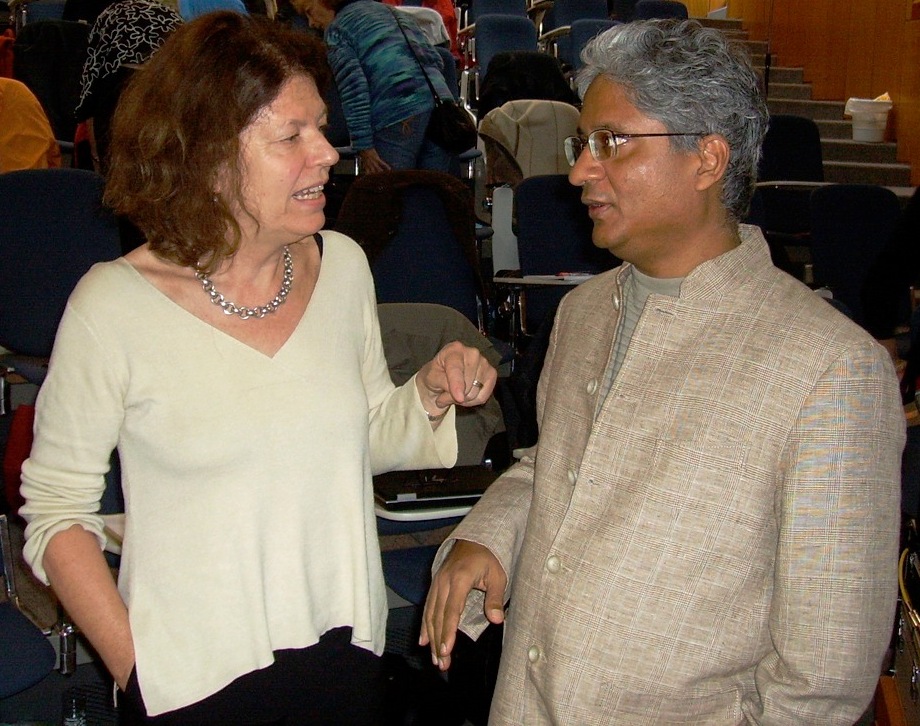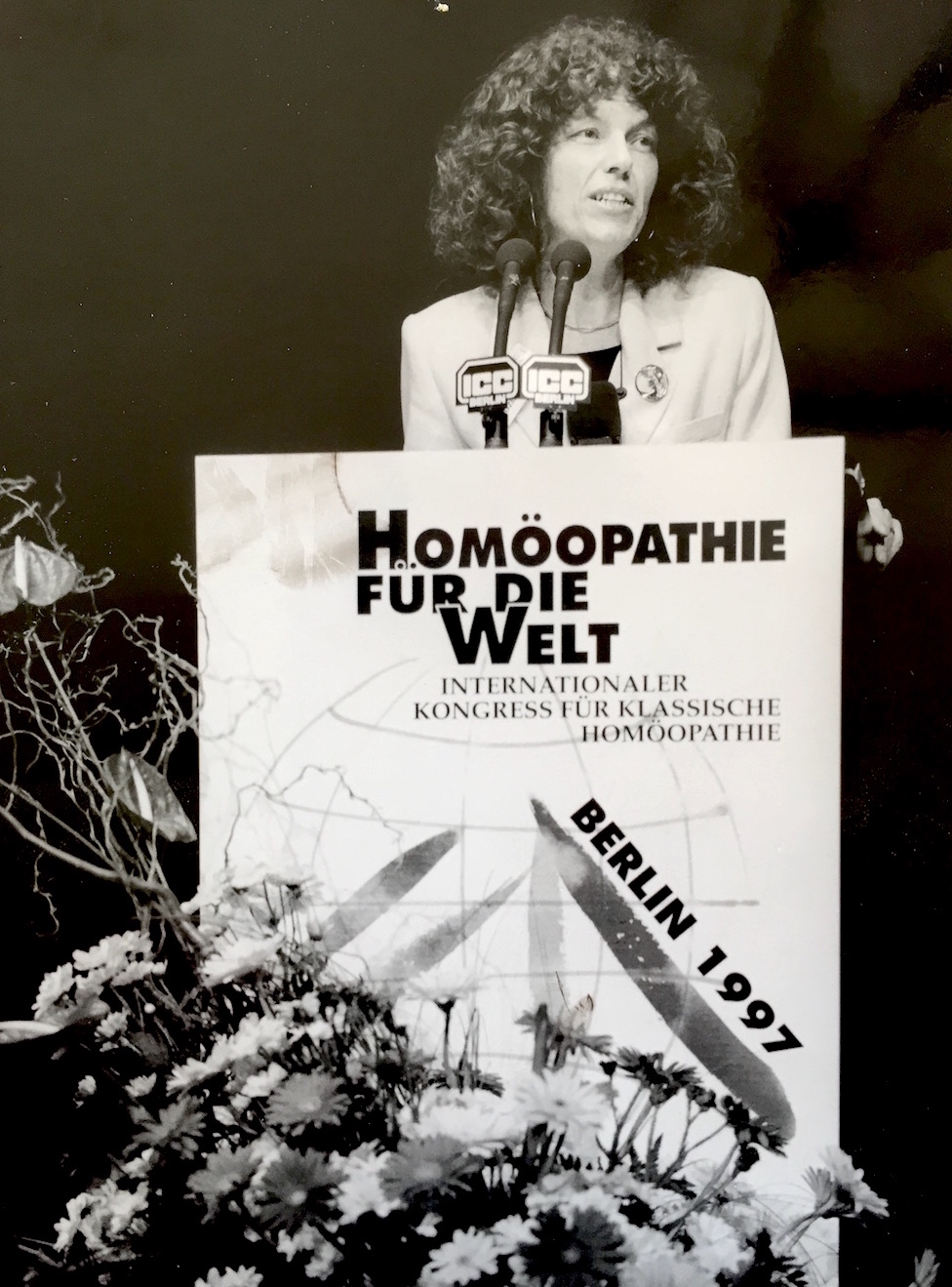An Interview with Anne Schadde by Mareen Muckenheim
In preparation for the seminar "The Art of Case Taking" at CHIRON - Die Schule für Klassische Homöopathie in Berlin, Mareen Muckenheim, director of the school, interviewed Anne Schadde.

1. What is special about the new technique of Rajan Sankaran? The new way of case taking that Sankaran teaches today is a step by step progression based on his system of the seven levels* of disease. With this process available, case taking has become much clearer for homeopaths. We can now better understand on which level the prescription has to take place. It is not just about a new "technique." Rajan Sankaran has enriched homeopathy with his continuous creative development of ideas. He never stops, but following Hahnemann's words "aude sapere" literally, which Immanuel Kant translated as "dare to use your mind." Sankaran constantly moves forward, continuing his own development and the development of homeopathy. Nevertheless it is still most important in every single case to find out what has to be cured in the patient. And that is exactly what Sankaran shows us when he teaches to be "unprejudiced" while listening to the descriptions of the patient and to understand the complaints in a larger context (today he talks about moving "from local to global"). That is the actual work of art. Homeopathy is the ART of healing, as it is repeatedly mentioned in the Organon. For this reason there can't be a particular rule how to work. What homeopaths need are good tools and the ability to use the patients' descriptions in a non-judgmental way.
2. What does it mean to you: "Empathetically leading the patient"? To be empathic means to me, to always be close to the patient's process, to ask questions in a way so that the patient feels free to open up.
3. Do we really have to lead our patients? Isn‘t it rather so, that we should ask as few questions as possible so that our patients can present themselves unfiltered? Well, leading doesn‘t mean that we take the lead with a goal in mind but rather that we keep asking in a particular fashion to come as close as possible to the „vital sensation (central perception)", as Sankaran calls it. This means that the patient describes what he senses. To reach that, it is important to keep guiding the patient by following his own words and descriptions and also to bring him back to the perception level from time to time. Otherwise patients can get lost in intellectual or psychological explanations - particularly in our Western world and especially with patients from big cities like Munich where psychotherapy, family counseling etc. are readily available.
4. How does the process triggered by a deeply effective remedy manifest itself? There aren‘t really processes triggered, it is more that the patient reconnects to his or her self. Nietzsche expressed this by saying: "Only now I know you are cured, because the healthy one forgets". That is why often nothing spectacular happens and still everything is different. While the ailments disappear, the patient experiences an inner calm. Those are the gifts during a treatment, leaving their marks on the patient and on me. Over and over again I am impressed by what happens after the simillimum is given. At the seminar, I will present a patient who came to me after being in homeopathic treatment for a long time. She then received different remedies from me for 10 years until we came to a point, where we didn‘t know how to go on. The continued interview (anamnese) lead her to the central point of her inner perception (sensation) and to the appropriate remedy. The remedy included everything we have talked about for years, but still I would not have understood it -- the patient had to take the path there herself through the sensation with her "hands talking the inner language" to the remedy. The changes following this remedy gave her access to a part of herself that allowed her to continue her spiritual development. That is exactly what Hahnemann describes in § 9 of the Organon. The most exciting part about this is, that the events following the simillimum are not a spectacular or extraordinary phenomenon but represent in their simplicity the depth of the movement of the soul.
5. What do you mean when you say "movement of the soul"? How do you think this becomes visible or even understandable? The soul is not a static structure nor is it a substance, but a process. It is distinct from the vital force although it has movement in common with the soul. The vital force is the movement within the body, and the soul uses the vital force as Hahnemann says in Aphorism 9, "for the highest purposes of our existence." When the vital force is healthy, the soul is free to integrate what needs to be integrated in the wholeness of the being. The disease is the process of an unexpressed soul. Actually I‘d like to say unfortunately, because if the soul could handle those processes within itself, becomes conscious, the body wouldn‘t have to be an organ of expression of disease.
The body is not able to perform any movement, any response, any symptoms, or any healing without the vital process within (as Hahnemann says in § 9 "as regards both sensations and functions"). The somatic expressions of the body offer us the possibility to perceive the movement of the soul. For instance, often you can see how the constricted feeling in the chest during asthma is also represented on the mental and emotional level.
The question is, how can we translate these sensations expressed at a deep soul level when they are expressed during the interview. These sensations represent the dynamis of the body. The physical modification is the last link in the chain of dynamic activity, the manifestation of movement. So the sensations described by the patient grant us direct access to the dynamis. Hahnemann has explained this explicitly in the Organon. Despite the different approaches in homeopathy, we all agree that homeopathic remedies are spirit-like substances, and it is important to identify how the spirit-like dynamis is diseased in the patient. Only in this way do we follow Similia Similibus Curentur. The somatic expression is just the externally visible part of the internal dynamic (or the internal drama). The idea is to trace this movement from the symptoms of the sickness to the general energy of the disease. That is what Sankaran means when he speaks of movement on the different levels*; from the disease with its modalities to emotions, continuing past the delusion (i.e. the imagination beyond reality) to the level of the general sensation where according to Sankaran the "other song" resonate in the patient, the "non-human-specific" expression, something not only characteristic for humans but for the substance needed. Our remedies, spirit-like entities of substances, are derived from non-human materials. For this reason the rhythm of the deranged vital force must be beyond the human-specific realm (otherwise we do not treat according to the principle „similar may be cured by similar"). In other words: The spirit-like entities of substances from the non-human realm will work as curing agents because the deranged vital force shows patterns that are beyond the human rhythm (mineral, plant, animal, etc). The art of this homeopathic process is to perceive this inner song, translate it and relate it to a substance. This is most likely the greatest art in our work.
6. What is the "unconscious" for you? According to Freud, the unconscious is something that does not come to the surface or just at rare occasions. Yes, we have to wait for exactly this moment. Basically in every sentence the unconscious urges to come to the surface, even if the mind tries very hard to control it. C.G. Jung said it beautifully: "the conscious is like a cork on the ocean of the unconscious." When I had the chance, some years ago, to homeopathically accommodate Edward Whitmont approaching the end of his life, we talked about many things. Jung, whom Whitmont had personally known, was not at all a friend of homeopathy. On the contrary, he didn‘t even want to hear about homeopathy. He did not accept that it doesn‘t have to be the work of the patient to become healthy. He did not understand how homeopaths could have the impudence to believe, that they could shorten psychological processes when every sickness is the expression of the internal dynamic. More than 20 years of practice have taught me certainly, that not much is in our power. And still, I have seen patients making quantum leaps in some cases. This was mostly possible when the remedy had been worked out of the depth of the unconscious. Now, with the new case taking methods we are much closer to C. G. Jung‘s ideas, because with the new case taking method the patient has to work hard to push on the gate of the unconscious and the process is not a constant mental one anymore. Generally I am very realistic. It this is not all our doing, this is a gift of insight and grace which comes directly to us and sometimes it takes years to happen. Sankaran‘s newest ideas provide more space for new discoveries and give the possibility to accompany the patient on his path to uncover „the undoubtedly morbid".
7. What won you over to Rajan Sankaran‘s new technique? In all my years of practice, I had the chance to repeatedly observe the unbelievable changes after a homeopathic remedy. I also experienced many times, that nothing was accomplished and the remedies did not help - and I don‘t like giving up. So now I never have to say: "I cannot help you any further, because our repertory and the materia medica don‘t show me anything that could possibly help you". Now I don‘t search the remedy within me or within my knowledge but in the patient and in his vital force. What I love with this technique is, that in every moment of the case taking, I know exactly where I stand. It is extremely helpful to know from which level the patient reports because this determines the direction of case taking. And it is especially important not to stop the questioning too early, but to always continue with the process of revealing the core of the "undoubtedly morbid".
8. Do you work exactly according to Sankaran‘s method or are there differences, and where are the differences? Nobody can and should copy someone else and this is not the goal of an ART of healing, following the guru's example exactly. I am not a friend of copying. What Sankaran teaches has only to do with tools and tools are fundamental for every artist. The "method" allows much freedom for the therapist, but this may exactly be the problem for those, who prefer "recipes" instead of engaging in the vastness of potentiality. To work in this way, I have to let go of acquired knowledge and allow something to happen, which I have not been able to imagine before and to just wait for the moment when it does. It is also very important to recognize that all the Materia Medica and Repertory knowledge of the past should be part of our wisdom before we go on to the next step.
9. Since when have you integrated Rajan Sankaran‘s new method into your work? Well, I met Sankaran in the early 80's. What made me always stand by him was his unconditional quest. He is someone who evolves every day and this evolutionary principle is very close to my nature. It would be very bad for me if I could not proceed any further and so I have constantly progressed with Sankaran. Since 1993, together with Dr. Jürgen Hansel, I have organized a yearly seminar with Rajan Sankaran in Munich. And this regular contact certainly influenced me. What is really important is this: Not the method, but the ability for movement has the most important place in my work. So this is where Sankaran is closest to me.
10. Are there other ways in case taking for you to gain insight into the patient? In fact there is no real method. Every interview is a unique piece of art: Hahnemann calls the case taking "...this individualizing examination..." in § 83. The Organon describes "The physician's highest and only calling..." in § 1 and finalizes the idea in § 3 with the "practitioner of the healing art." (I prefer the old translation of "Heilkünstler" - artist of healing.) If we are talking about a method, I can only bring up the question: How can I become an artist? I need good tools for this and many homeopaths of the past and the present have given these to us. I am grateful for every insight of the old and new masters and I integrate them. The real art still is something that has to happen internally. It is now the most important skill to have the old knowledge but to be open towards the new and unknown. Just like the somersaults of airborne artists in the circus. We have left the old swing and the new swing is in reach, but the most important movement is the somersault. That means letting go of possibly all the fixations on what we think we know and opening up to the great potential of the "eventualities" where the patient takes us.
11. Anne we know you have been a homeopath for more than 20 years, what experiences have led you to homeopathy? Before being a homeopath I was a schoolteacher and during breaks the students confided their most important problems. So I learned gradually that the breaks were more important for the development of young people than class itself. So I chose "breaks" for my profession. And this new process of case taking offers me the possibility again and again to use the "breaks" in this way, reading between the lines in order to understand the Real, the Dynamic.
Thank you very much for this Interview and we are very much looking forward to an exciting seminar!

